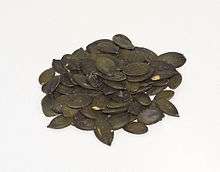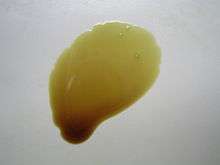Pumpkin seed oil
Pumpkin seed oil is a culinary oil, used especially in central Europe.


Culinary uses
This oil is a culinary specialty from what used to be part of the Austro-Hungarian Empire and is now southeastern Austria (Styria), eastern Slovenia (Styria and Prekmurje), Central Transylvania, Orăștie-Cugir region of Romania, north western Croatia (esp. Međimurje), Vojvodina, and adjacent regions of Hungary.
Pumpkin seed oil has an intense nutty taste and is rich in polyunsaturated fatty acids. Browned oil has a bitter taste. Pumpkin seed oil serves as a salad dressing. The typical Styrian dressing consists of pumpkin seed oil and cider vinegar. The oil is also used for desserts, giving ordinary vanilla ice cream a nutty taste. It is considered a real delicacy in Austria and Slovenia, and a few drops are added to pumpkin soup and other local dishes. Using it as a cooking oil, however, destroys its essential fatty acids.[1]
Production
Oil from pumpkin seeds is extracted by solvent extraction or by supercritical carbon dioxide methods.[2] Once the oil is obtained, further specific extractions may be done, such as for carotenoids.[2]
Styrian oil – an export commodity of Austria and Slovenia – is made by pressing roasted, hull-less pumpkin seeds from a local variety of pumpkin, the "Styrian oil pumpkin" (Cucurbita pepo subsp. pepo var. 'styriaca',[3][4] also known as var. oleifera). High-temperature roasting improves the aromatic quality of pumpkin seed oil.[5]
Seed types and oil


The viscous oil is light to very dark green to dark red in colour depending on the thickness of the observed sample. The oil appears green in thin layers and red in thick layers, an optical phenomenon called dichromatism.[6] Pumpkin oil is one of the substances with the strongest dichromatism. Its Kreft's dichromaticity index is -44.[7] When used together with yoghurt, the oil turns bright green and is sometimes referred to as "green-gold".
Other types of pumpkin seed oil are also marketed worldwide. International producers use white seeds with shells and this produces a cheaper white oil. New producers of seeds are located in China.
An analysis of the oil extracted from the seeds of each of twelve cultivars of C. maxima, related, yet different pumpkin species, yielded the following ranges for the percentage of several fatty acids:[8]
| n:unsat | Fatty acid name | Percentage range |
|---|---|---|
| (14:0) | Myristic acid | 0.09-0.27 |
| (16:0) | Palmitic acid | 12.6-18.4 |
| (16:1) | Palmitoleic acid | 0.12-0.52 |
| (18:0) | Stearic acid | 5.1-8.5 |
| (18:1) | Oleic acid | 17.0-39.5 |
| (18:2) | Linoleic acid | 36.2-62.8 |
| (18:3) | Linolenic acid | 0.34-0.82 |
| (20:0) | Arachidic acid | 0.26-1.12 |
| (20:1) | Gadoleic acid | 0-0.17 |
| (22:0) | Behenic acid | 0.12-0.58 |
The sum of myristic and palmitic acid (cholesterogenic saturated fatty acids) content ranged from 12.8 to 18.7%. The total unsaturated acid content ranged from 73.1 to 80.5%. The very long chain fatty acid (> 18 carbon atoms) content ranged from 0.44 to 1.37%.
The oil is localised in the small lipid droplets in the cotyledon cells.[9]
Names
It is called Kernöl or Kürbiskernöl in German, bučno olje in Slovenian, bučino ulje in Croatian, tikvino ulje or bundevino ulje in Serbian, ulei de dovleac in Romanian, and tökmagolaj in Hungarian).
See also
References
- "Healthy Cooking Oils". University of Kansas Medical Center. Archived from the original on September 4, 2013. Retrieved September 17, 2013.
- Durante, M.; Lenucci, M. S.; Mita, G. (2014). "Supercritical Carbon Dioxide Extraction of Carotenoids from Pumpkin (Cucurbita spp.): A Review". International Journal of Molecular Sciences. 15 (4): 6725–6740. doi:10.3390/ijms15046725. PMC 4013658. PMID 24756094.
- Fürnkranz, Michael; Lukesch, Birgit; Müller, Henry; Huss, Herbert; Grube, Martin; Berg, Gabriele (2012). "Microbial Diversity Inside Pumpkins: Microhabitat-Specific Communities Display a High Antagonistic Potential Against Phytopathogens". Microbial Ecology. 63 (2): 418–428. doi:10.1007/s00248-011-9942-4. JSTOR 41412429. PMID 21947430.
- Košťálová, Zuzana; Hromádková, Zdenka; Ebringerová, Anna (August 2009). "Chemical Evaluation of Seeded Fruit Biomass of Oil Pumpkin (Cucurbita pepo L. var. Styriaca)". Chemical Papers. 63 (4): 406–413. doi:10.2478/s11696-009-0035-5.
- Procida, G.; Stancher, B.; Cateni, F.; Zacchigna, M. (2013). "Chemical composition and functional characterisation of commercial pumpkin seed oil". Journal of the Science of Food and Agriculture. 93 (5): 1035–41. doi:10.1002/jsfa.5843. PMID 22936573.
- Kreft, Samo; Kreft, Marko (November 2007). "Physicochemical and Physiological Basis of Dichromatic Colour". Naturwissenschaften. Springer Science+Business Media. 94 (11): 935–939. doi:10.1007/s00114-007-0272-9. PMID 17534588.
- Kreft, Samo; Kreft, Marko (2009). "Quantification of Dichromatism: A Characteristic of Color in Transparent Materials". Journal of the Optical Society of America. Optical Society of America. 26 (7): 1576–1581. doi:10.1364/JOSAA.26.001576. PMID 19568292.
- Stevenson, D. G.; Eller, F. J.; Wang, L.; Jane, J.; Wang, T.; Inglett, G. E. (2007). "Oil and Tocopherol Content and Composition of Pumpkin Seed Oil in 12 Cultivars". Journal of Agricultural and Food Chemistry. 55 (10): 4005–4013. doi:10.1021/jf0706979. PMID 17439238. Note: The data are found in Table 3 on page 4010
- Kreft, M., Zorec, R., Janeš, D., Kreft, S. (2009). Histolocalisation of the oil and pigments in the pumpkin seed. Annals of Applied Biology, 154:413–418
| Wikimedia Commons has media related to Pumpkin seed oil. |

.jpg)